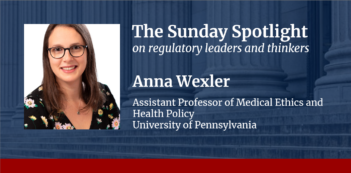
Using retrospective drug safety data can improve patient care.
When the Food and Drug Administration (FDA) approved the cholesterol-lowering drug simvastatin in 1991, its decision was based on pre-market controlled clinical studies that analyzed a total of 2,423 patients. If that sounds like a lot of patients, consider that in 2011 alone, just in the United States, almost a hundred million prescriptions were written for the drug.
Imagine the impact of being able to analyze data from every one of those hundred million patients to evaluate whether simvastatin is safe and effective. Better yet, imagine analyzing data from every patient who has ever taken the drug in every country in the world.
That is the vision of a drug regulatory system powered by big data. Historically, that type of research has been unachievable. But now, for the first time in human history, it is a possibility.
How can government make this vision of a post-market regulatory system a reality? To start, extensive data on individual patient drug use, outcomes, and adverse events will need to be collected and aggregated. This step is challenging because existing systems for acquiring this data are all relatively modest in scope. While the situation is different in countries such as England and Australia, the American health care system has lagged behind other developed countries and domestic industries in efforts to implement information technology. This shortcoming is particularly unfortunate because there is a broad consensus that appropriately adopting health information technology (HIT) results in safer and more effective care.
A potential solution to the information deficit is emerging in the form of health information exchanges (HIEs) created by the Health Information Technology for Economic and Clinical Health Act and the Affordable Care Act. HIEs – not to be confused with the more prominently discussed health insurance exchanges – were principally designed for sharing individual patient data among health care providers. For example, they could allow doctors at a university hospital in Tallahassee to instantly access a patient’s MRI from a private hospital in Miami. That level of interconnectedness already exists within organizations like Kaiser Permanente and the Veterans Health Administration, but right now sharing information between unaffiliated providers can be challenging at best. Because HIEs will contain an unprecedented amount of clinical information, they could also be used to aid the FDA with post-market drug surveillance.
Even as HIEs are becoming operational across the country, their future remains uncertain. As with other forms of HIT, these exchanges are costly and technically challenging to establish and maintain. The government has made generous grants available to support HIEs, but that aid is finite. In the near future these exchanges will either need to become self-sustaining or produce sufficient stakeholder value to justify continued investment.
Furthermore, to be useful in post-market drug surveillance HIEs will need to collect the right kinds of data and be capable of efficient data sharing. This in turn will require resolving interoperability conflicts, developing effective reporting standards, and adequately addressing privacy concerns. Patient privacy is a critical issue with the use of HIEs for pharmacovigilance, meaning the ongoing monitoring and prevention of the adverse effects of medicines. But the use of data for that purpose is permitted under federal laws governing the confidentiality of health information. Ultimately, while the risk of privacy loss can never be eliminated, it can be significantly minimized through effective security protocols and the threat of civil and criminal liability.
Even with HIEs in place, their data will need to be effectively plugged into the regulatory process to be useful in improving drug safety. Right now, the U.S. has a weak market-driven impetus for making this connection. While the FDA has the right motivations, the agency lacks the resources, information, and entrepreneurial drive of the 1.3 trillion-dollar-a-year private industry it regulates. Third parties such as insurance companies, academics, and rival firms have some role, but their incentives to police the drug market are relatively weak despite the potential public health benefits. Maximizing the data’s value will require a restructuring of market participant incentives. Third party engagement in post-market surveillance must be enhanced, something drug product liability does imperfectly. New incentives are needed.
The best option may be an administrative bounty proceeding that will allow third parties to submit evidence to the FDA to contest the claimed safety and efficacy profiles of drugs already on the market. The federal government should pay petitioner awards based on the estimated governmental savings from not paying for ineffective and dangerous treatments. In the event a pharmaceutical company is found to have negligently misrepresented a drug’s risk-benefit profile, the company could be directly responsible for the cost of awards based on a portion of a drug’s revenue. If product sponsors are found to have acted willfully, recklessly, or with gross negligence, they could be responsible for treble damages.
By creating new incentives that counter the powerful financial motivation of drug manufacturers to obscure or misrepresent safety profiles, a bounty regime could lead to an improved balance of the risks and benefits of drugs used by the American public. Implementing an administrative bounty proceeding would doubtless pose a significant political challenge, but the Affordable Care Act was passed in the same type of challenging political environment. We can hope that the potential savings of this proposal, both human and financial, would be enough to generate broad support. Failing that, this is another opportunity for political leadership.




